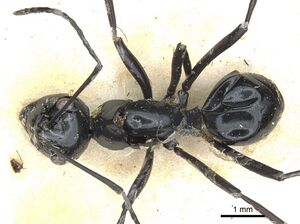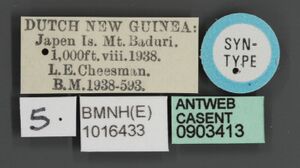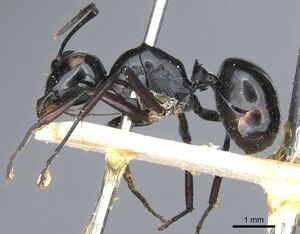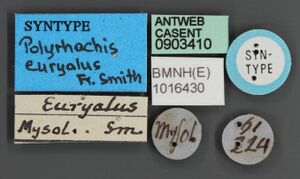Polyrhachis euryala
| Polyrhachis euryala | |
|---|---|

| |
| Scientific classification | |
| Kingdom: | Animalia |
| Phylum: | Arthropoda |
| Class: | Insecta |
| Order: | Hymenoptera |
| Family: | Formicidae |
| Subfamily: | Formicinae |
| Tribe: | Camponotini |
| Genus: | Polyrhachis |
| Subgenus: | Cyrtomyrma |
| Species: | P. euryala |
| Binomial name | |
| Polyrhachis euryala Smith, F., 1863 | |
| Subspecies | |
| |
| Synonyms | |
| |
Donisthorpe (1941) in his account of the synonymous rastellata var. baduri: "Miss L. E. Cheesman took a number of workers and three winged females in a carton nest under leaves of Pandanus." Nothing more is known about the biology of Polyrhachis euryala.
Identification
Donisthorpe (1938) - Polyrhachis euryala is distinctly more slender than Polyrhachis rastellata with the greatest width of the pronotal dorsum in the middle of its length. Polyrhachis rastellata is more robust, notably across the pronotum which is widest across, or just behind the shoulders.
Kohout (2008) - When describing Polyrhachis pagana, Santschi compared his new variety to Polyrhachis euryala and Polyrhachis rastellata. He noted that it differed from P. euryala by having the dorsal petiolar spines longer and finer than the lateral pair, and from P. rastellata by its black appendages. Besides the characters listed above, P. euryala differs from both other species by its distinctly slender mesosoma with the greatest width of the pronotal dorsum at its mid-length. In contrast, both Polyrhachis rastellata and P. pagana feature a more robust pronotal dorsum which is widest across or just behind the shoulders. The two latter species differ mainly by the colour of their legs that are mostly light to medium-red or orange in P. rastellata and black in P. pagana. In addition, the mesosomal profile in P. rastellata is distinctly uneven, with a rather flat or shallowly impressed summit at the promesonotal suture and a weak depression indicating the relative position of the indistinct metanotal groove. In contrast, the mesosoma in P. pagana is almost evenly rounded (more like that in P. euryala), with only a slight change in the angle of the profile at the steeply descending propodeal declivity.
Keys including this Species
Distribution
Patchily distributed through the eastern islands of Indonesia and across New Guinea.
Latitudinal Distribution Pattern
Latitudinal Range: -3.183333333° to -16.1°.
| North Temperate |
North Subtropical |
Tropical | South Subtropical |
South Temperate |
- Source: AntMaps
Distribution based on Regional Taxon Lists
Indo-Australian Region: Indonesia (type locality), New Guinea.
Distribution based on AntMaps
Distribution based on AntWeb specimens
Check data from AntWeb
Countries Occupied
| Number of countries occupied by this species based on AntWiki Regional Taxon Lists. In general, fewer countries occupied indicates a narrower range, while more countries indicates a more widespread species. |

|
Estimated Abundance
| Relative abundance based on number of AntMaps records per species (this species within the purple bar). Fewer records (to the left) indicates a less abundant/encountered species while more records (to the right) indicates more abundant/encountered species. |

|
Biology
Castes
Worker
Images from AntWeb
   
| |
| Holotype of Polyrhachis euryala. Worker. Specimen code casent0901820. Photographer Will Ericson, uploaded by California Academy of Sciences. | Owned by OUM, Oxford, UK. |
   
| |
| Syntype of Polyrhachis rastellata baduri. Worker. Specimen code casent0903413. Photographer Will Ericson, uploaded by California Academy of Sciences. | Owned by NHMUK, London, UK. |
    
| |
| Syntype of Polyrhachis euryala. Worker. Specimen code casent0903410. Photographer Will Ericson, uploaded by California Academy of Sciences. | Owned by NHMUK, London, UK. |
Nomenclature
The following information is derived from Barry Bolton's Online Catalogue of the Ants of the World.
- euryala. Polyrhachis euryalus Smith, F. 1863: 16 (w.) INDONESIA (Misool I.). Combination in P. (Cyrtomyrma): Emery, 1925b: 208. Junior synonym of rastellata: Mayr, 1872: 138; Bingham, 1903: 414. Revived from synonymy as subspecies of rastellata: Emery, 1900d: 720; Emery, 1925b: 208. Revived status as species: Donisthorpe, 1938c: 259; Dorow, 1995: 22. Senior synonym of torricelliana: Viehmeyer, 1914b: 50; Kohout, 2009b: 44; of baduri: Kohout, 2009b: 44. See also: Kohout, 2006b: 125. Current subspecies: nominal plus javana.
- torricelliana. Polyrhachis rastellata var. torricelliana Viehmeyer, 1912: 9, fig. 11 (w.) NEW GUINEA. Junior synonym of euryala: Viehmeyer, 1914b: 50.
- baduri. Polyrhachis (Cyrtomyrma) rastellata var. baduri Donisthorpe, 1941h: 63 (w.q.) NEW GUINEA. Junior synonym of euryala: Kohout, 2009b: 45.
The following notes on F. Smith type specimens have been provided by Barry Bolton (details):
Polyrhachis euryalus
Holotype worker in Oxford University Museum of Natural History. Labelled “M.” (= Misool I.) and with a Donisthorpe type-label.
Unless otherwise noted the text for the remainder of this section is reported from the publication that includes the original description.
Description
Worker
Length 2 ½ lines. Black, smooth and shining; the thorax rounded above, not spined; the outline, when viewed laterally, semicircular; the legs obscure ferruginous. Abdomen globose; the node of the peduncle with four spines, the two inner ones shorter than the lateral pair, but all short and acute.
Queen
Colour and sculpture as in worker. The scale is broader and the punctures on thorax and petiole a little coarser. Wings yellowish, pterostigma and veins yellowish-brown. Long. 7·0-7·5 mill. (Donisthorpe 1941)
Type Material
INDONESIA, Mysool Island, col. A.R. Wallace. Syntype workers Oxford University Museum of Natural History and The Natural History Museum – as reported by Kohout (2006).
Donisthorpe (1941) types of the synonymous rastellata var. baduri: JAPEN ISLAND: Mt. Baduri, 1000 ft., viii.1938, col. L. E. Cheesman. The Natural History Museum
References
- Bingham, C. T. 1903. The fauna of British India, including Ceylon and Burma. Hymenoptera, Vol. II. Ants and Cuckoo-wasps. London: Taylor and Francis, 506 pp. (page 414, Junior synonym of rastellata)
- Donisthorpe, H. 1938c. The subgenus Cyrtomyrma Forel of Polyrhachis Smith, and descriptions of new species, etc. Ann. Mag. Nat. Hist. 11(1): 246-267 (page 259, Revived status as species)
- Donisthorpe, H. 1941h. The ants of Japen Island, Dutch New Guinea (Hym., Formicidae). Trans. R. Entomol. Soc. Lond. 91: 51-64.
- Dorow, W. H. O. 1995. Revision of the ant genus Polyrhachis Smith, 1857 (Hymenoptera: Formicidae: Formicinae) on subgenus level with keys, checklist of species and bibliography. Cour. Forschungsinst. Senckenb. 185: 1-113 (page 22, Revived status as species)
- Emery, C. 1900d. Formiche raccolte da Elio Modigliani in Sumatra, Engano e Mentawei. [part]. Ann. Mus. Civ. Stor. Nat. 40[=(2(20): 689-720 (page 720, Revived from synonymy as subspecies of rastellata)
- Emery, C. 1925d. Hymenoptera. Fam. Formicidae. Subfam. Formicinae. Genera Insectorum 183: 1-302 (page 208, Combination in P. (Cyrtomyrma), Revived from synonymy as subspecies of rastellata)
- Kohout, R. J. 2006. Review of Polyrhachis (Cyrtomyrma) Forel (Hymenoptera: Formicidae: Formicinae) of Australia, Borneo, New Guinea and the Solomon Islands with descriptions of new species. Memoirs of the Queensland Museum. 52:87-146.
- Mayr, G. 1872. Formicidae Borneenses collectae a J. Doria et O. Beccari in territorio Sarawak annis 1865-1867. Ann. Mus. Civ. Stor. Nat. 2: 133-155 (page 138, Junior synonym of rastellata)
- Smith, F. 1863a. Catalogue of hymenopterous insects collected by Mr. A. R. Wallace in the islands of Mysol, Ceram, Waigiou, Bouru and Timor. J. Proc. Linn. Soc. Lond. Zool. 7: 6-48 (page 16, worker described)
- Viehmeyer, H. 1914b. Neue und unvollständig bekannte Ameisen der alten Welt. Archiv für Naturgeschichte 79 (A.12) (1913): 24-60. (page 50, Senior synonym of torricelliana)
References based on Global Ant Biodiversity Informatics
- Chapman, J. W., and Capco, S. R. 1951. Check list of the ants (Hymenoptera: Formicidae) of Asia. Monogr. Inst. Sci. Technol. Manila 1: 1-327
- Janda M., G. D. Alpert, M. L. Borowiec, E. P. Economo, P. Klimes, E. Sarnat, and S. O. Shattuck. 2011. Cheklist of ants described and recorded from New Guinea and associated islands. Available on http://www.newguineants.org/. Accessed on 24th Feb. 2011.
- Kohout R. J. 2009. A new species and nomenclatural changes in the subgenus Polyrhachis (Cyrtomyrma) Forel. Australian Entomologist 36: 37-48
- Kohout R.J. 2006. Review of Polyrhachis (Cyrtomyrma) Forel of Australia, Borneo, New Guinea and the Solomon Islands with descriptions of new species. Memoirs of the Queensland Museum 52: 87-146.
- Santschi F. 1932. Résultats scientifiques du voyage aux Indes orientales néerlandaises de LL. AA. RR. le Prince et la Princesse Léopold de Belgique. Hymenoptera. Formicidae. Mémoires du Musée Royal d'Histoire Naturelle de Belgique. (2)4: 11-29.
- Smith F. 1863. Catalogue of hymenopterous insects collected by Mr. A. R. Wallace in the islands of Mysol, Ceram, Waigiou, Bouru and Timor. Journal and Proceedings of the Linnean Society of London. Zoology 7: 6-48.
- Viehmeyer H. 1912. Ameisen aus Deutsch Neuguinea gesammelt von Dr. O. Schlaginhaufen. Nebst einem Verzeichnisse der papuanischen Arten. Abhandlungen und Berichte des Königlichen Zoologischen und Anthropologische-Ethnographischen Museums zu Dresden 14: 1-26.
- Viehmeyer H. 1913. Ameisen aus dem Kopal von Celebes. Stettiner Entomologische Zeitung 74: 141-155.

